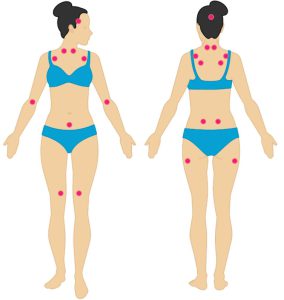Dealing Fibromyalgia in a unique perspective

What is Fibromyalgia?
The syndrome was discovered in the 1820s and was called fibrositis. in 1976 its name was changed to fibromyalgia when taken from the combination of the Latin word FIBRO – cell tissue, and the Greek words MYO – muscle and ALGIA – pain. Only in the 90s was it officially defined with an orderly diagnostic capability.
The syndrome is characterized by chronic pain that appears in connective tissue and muscles throughout the body or muscle stiffness. It can manifest in a particular place or throughout the body and in addition can be sudden and even exacerbate with exertion or fatigue.
Symptoms
The syndrome has many symptoms that can appear as various physical symptoms, a feeling of discomfort or pain. Muscle pain especially in the neck area which causes both headaches but also in the upper and lower back area. Nocturnal pain that increases during sleep, depression and anxiety, difficulty concentrating and memory impairment, digestive problems and skin problems.
It is important to note that the multiplicity of symptoms makes it very difficult to diagnose the disease due to the similarity to many diseases with the same symptoms.
Diagnosis of the disease
It is important to understand that fibromyalgia is not a progressive disease, and it does not worsen over time and does not cause additional diseases. The diagnosis of the syndrome is based on a physical examination and diagnosis of the patient’s side effects. It is by ruling out problems that may be the source of the pain. Diagnosis of pain according to its nature and location in the body and the reaction of several fixed points to examine their sensitivity and their response to stress.
The criteria are the presence of 11 pain points out of 18.

The diagnosis is based on the nature of the pain and its location in the body. During the diagnosis, sensitive points are examined and how they respond to stress.
Examples of pain associated with fatigue, burning sensation, muscle stiffness, hypersensitivity, limb pain, numbness or tingling, headache, irritable bowel syndrome, arthritis, sensitivity to light or noise and sensitivity to weather changes.
Causes of the disease
In terms of science, Western medicine and alternative medicine the basis for the disease has not been discovered and therefore the causes are not fully clear. A direct link to the onset of the disease can be seen following severe mental or physical stress, infections and severe inflammation and accumulation of toxins. You can see that the body actually responds to an extreme situation that it experiences which weakens the body’s natural immune system. This condition is the result of an external event or optimal behavior of the person such as poor nutrition, stressful lifestyle, lack of sleep and more.
It is important to understand that this is a disease that affects many people and the mere fact that the cause of the disease has not been found does not mean that it is not real.
What is the body trying to tell us?
The starting point when dealing with any disease or a new problem that the body is trying to put our attestation to is first of all to look inside and try to understand why this thing came about? What is the body trying to teach me? And what should I do to release this thing from my body?
The connection to the emotional place is an integral part of any healing process. Emotional release is what releases the disease from our bodies and allows us to return to normal work, but there are definitely a number of physical actions we need to do and habits that we can change to help the body recover and return to normal.
Treatment and lifestyle
Medication is a trial-and-error game and I will leave the recommendations on it to the medical staff. There is no medicine that cures the syndrome but only treats the symptoms and their help is limited and usually in increasing doses. I will just note that each drug has a large number of side effects and therefore care should be taken not to aggravate the condition with additional problems in an attempt to alleviate the symptoms of the disease.
Alternative therapies that combine a balance between body and mind have shown incredible improvement in coping with the disease in addition of course to a change in lifestyle and habits.
Alternative therapies:
- Water treatments
Water is known for its ability to absorb and relieve pain and reduce physical and mental stress. Hot water treatments, water sports activities, hydrotherapy and even a hot bath at home can be very helpful. - Medical Massage
Touch and massage help in relieving pain from the physical body. The touch and application of pressure on the muscles helps in releasing, increasing blood flow and cleansing the blood system. The massage helps to release physical and energetic blockages from the body to balance the body and mind.
- Chinese or Western acupuncture
It is true that the methods are different in nature and the way they work on the body but in both methods help the body to release physical and emotional pain, motivate and increase blood flow in the desired places. They can be used to treat a wide variety of physical and mental symptoms.
Lifestyle changes:
- Proper nutrition
Dietary change can lead to a significant physical change. A balanced diet composed of plenty of fruits and vegetables. Avoiding as much as possible products that encourage inflammation in the body such as animal products will help the body in reducing inflammation in the problematic areas in the body.
- Working with the mind
When the head is preoccupied with incessant thoughts the body fails to get the peace it needs to activate the parasympathetic system that encourages healing and rehabilitation of the body. Self-work can help the body return to balance and help it recover. Practicing various types of meditation on a daily basis, breathing exercises to release stress and discharge daily experiences, practicing yoga, Tai Chi and more.
- Herbs
Use of herbs according to the symptoms we experience.
Turmeric – Curcumin extracted from the root of the turmeric plant is known to have anti-inflammatory properties and helps reduce pain. In addition, it helps with a variety of gastrointestinal diseases, skin diseases and more.
Valerian – The plant contains active ingredients that help calm the body, make you feel asleep and encourage the work of the parasympathetic system.
Ashwagandha – The root of the plant helps to reduce stress, balance the nervous system and the hormonal system and helps maintain high concentration. It affects the adrenal gland and the thyroid gland. It is suitable for people with a constant feeling of pressure.
Ginger – ginger is a plant that has been used for thousands of years by Chinese, Indian and even Western medicine. It helps with a variety of stomach problems such as nausea and vomiting, anti-inflammatory activity and protection of the gastric mucosa.
Cannabis – In the human body there are cannabinoid receptors, located throughout the body and are part of the endocannabinoid system, which is involved in a variety of physiological processes including appetite, pain sensation, mood and memory. Using cannabis flowers helps relieve pain, treat depression, sleep better and reduce chronic fatigue.
- Sports activities
In any situation it is recommended to do exercise especially for people who are not normally active and when the body presents some problem. The activity encourages blood flow in the body, strengthens the muscles, encourages the body to burn fat and releases hormones and endorphins that make us feel good. Recommended activities are walking, cycling, strength exercises, swimming, dancing, aerobic activities such as spinning, Pilates, yoga and more.
Fibromyalgia is definitely a challenging syndrome for patients but if we choose to use the condition as a tool for learning about ourselves and working properly with our body, we can leverage the condition to create change in our lifestyle and the body will respond accordingly. from drastic reduction in symptoms to complete disappearance.
